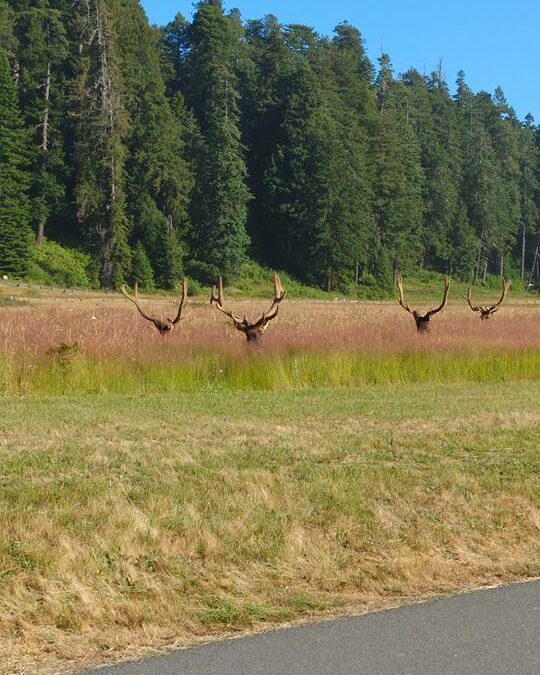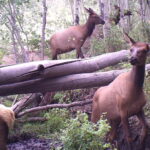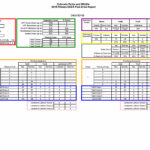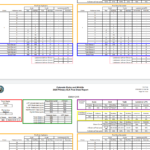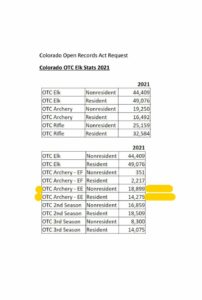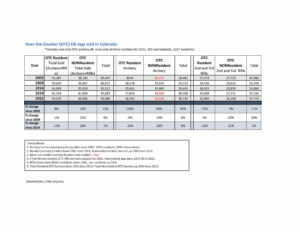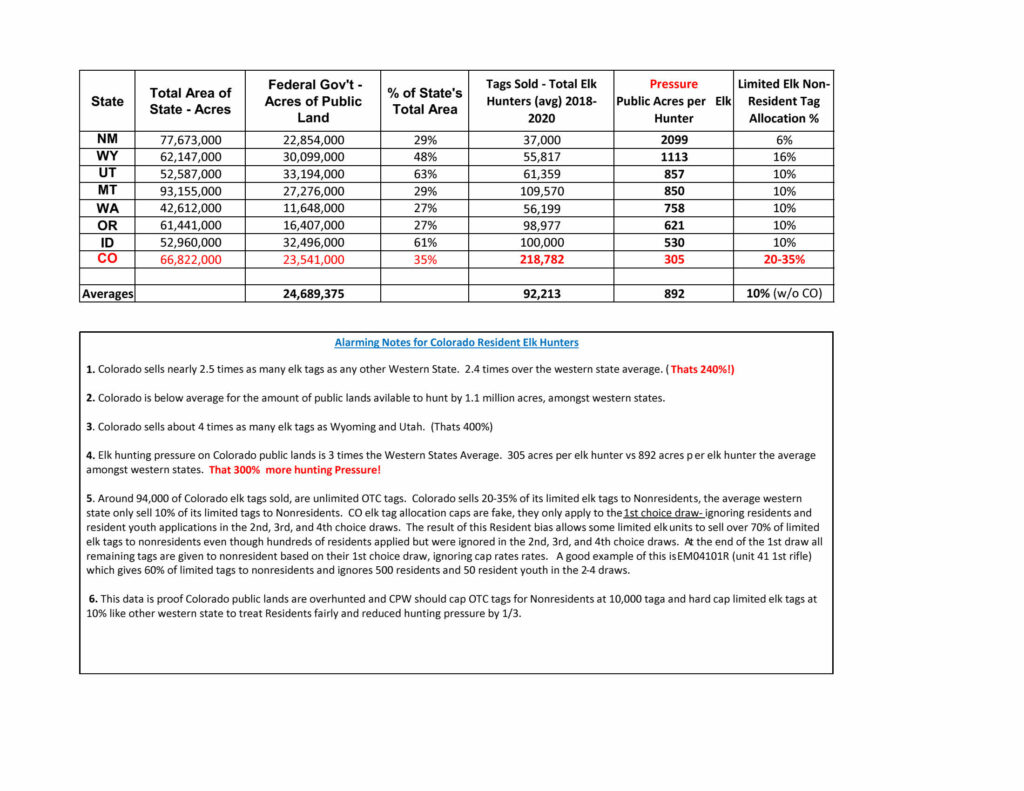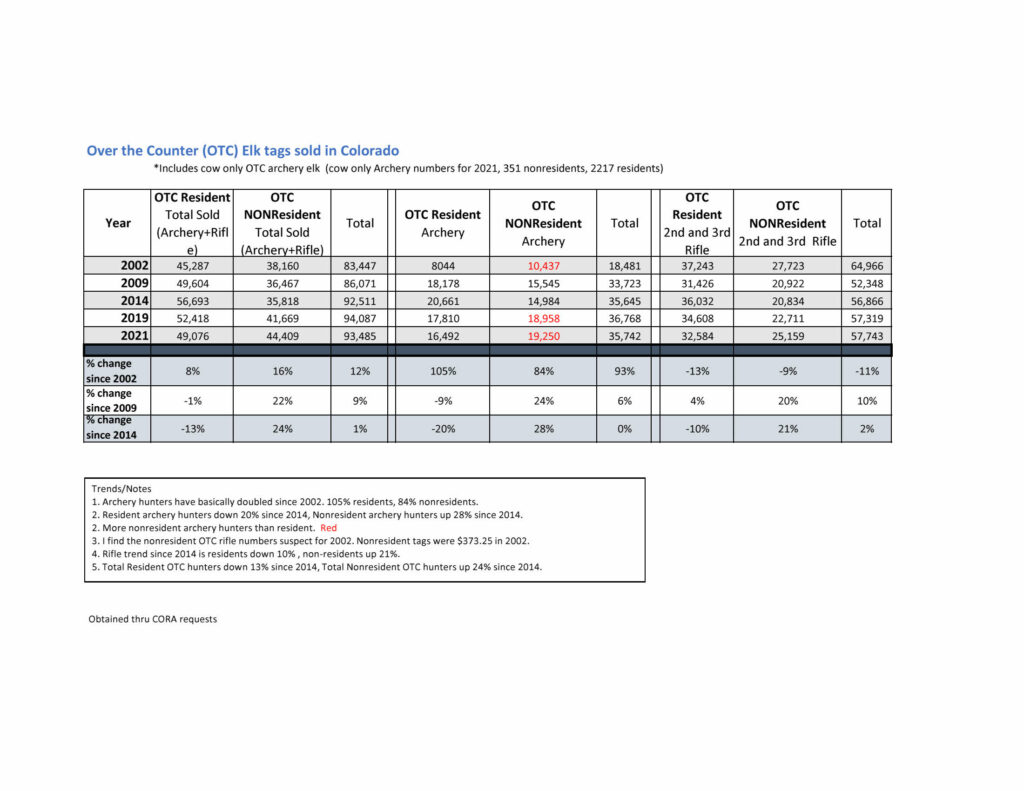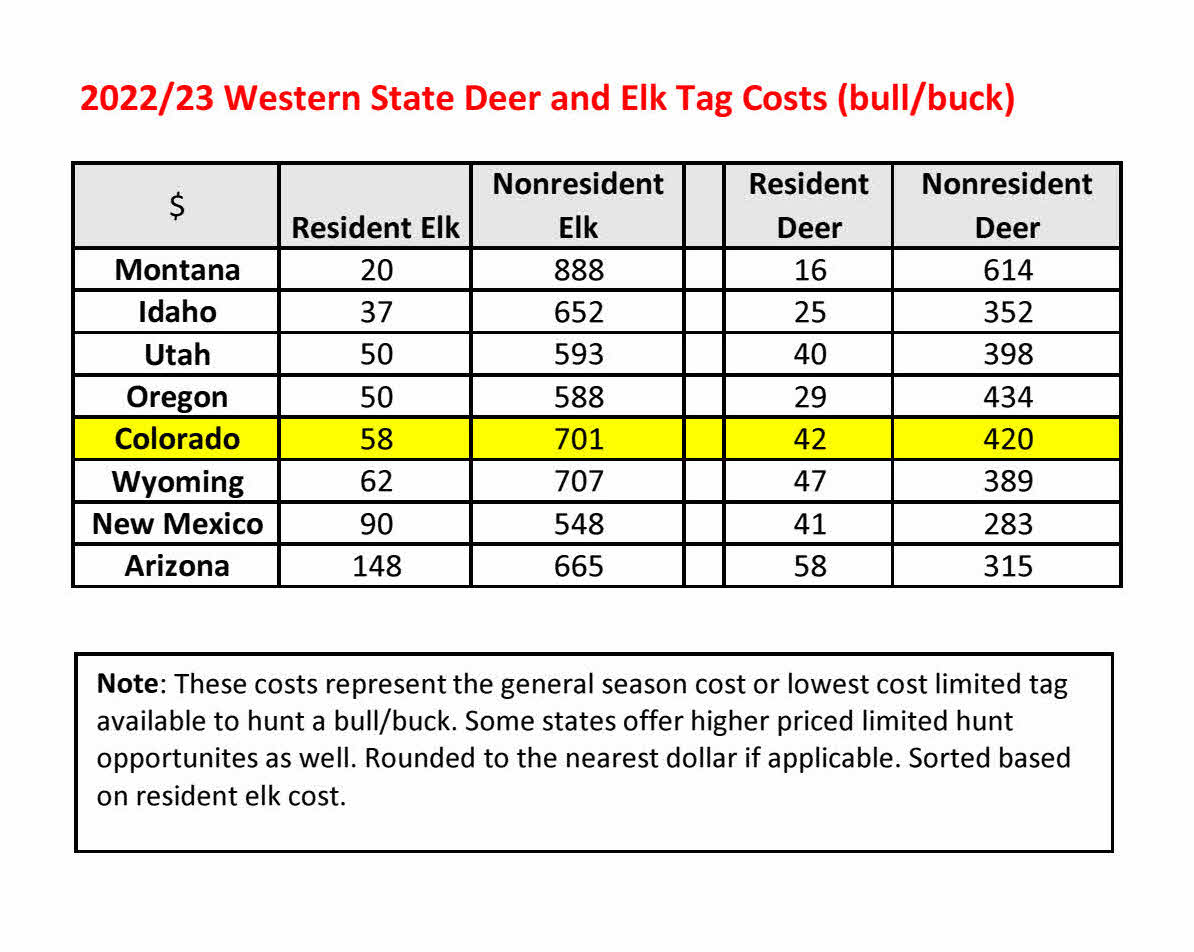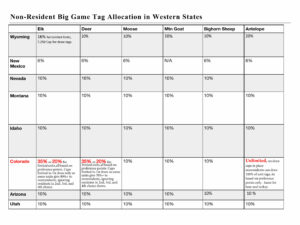In March 2021, Colorado finally proposed a Senate Bill, SB 21-150 (Reserve Big Game Hunting Licenses for Residents), to ease resident hunter frustration as a result of a tag allocation bias inflicted on resident hunters for decades —-when compared to other western states. This Bill appears to be an effort to help resident big game (deer and elk) hunters get fair tag allocation when compared to other western states. To view what other western states allocate for big game tag percentages see Western States Big Game Tag Allocation. You might be surprised that Colorado gives 100% to 250% more limited deer and elk tags to nonresident hunters than the average western state. Currently, Colorado has nonresident big game tag allocation caps of 20% and 35% for limited mule deer and elk tags. 20% of the elk and deer tags are given to nonresidents in the limited units that take 6 or more preference points to draw, all other limited units give “up to” 35% of tags to nonresidents. On average all other western states give just 10% of big game tags to nonresidents. See page 4 “Nonresident License Allocation” of 2021 Big Colorado Big Game Brochure.
The Hidden Secrets to Colorado Big Game Tags in Colorado’s Big Game Draw
Problem #1: When you read the above-referenced page 4 “Nonresident License Allocation” of 2021 Big Colorado Big Game Brochure you will notice that the CPW is still using the tag draw data from the 2007 – 2009 draw results (15-year-old data) to determine which units give 20% or 35% of the tags to nonresident deer/elk hunters. The amount of limited deer/elk units that now require 6 or more preference points has surely doubled since 2007 and the CPW will not update the draw process! Today, many more limited units should be at 20% vs 35% for nonresident hunters. Example: Unit 40 archery elk in Colorado has gone from 3 preference points to draw in 2009 to 8-9 preference points since 2017. But since the CPW does not update the system, 35% of tags in unit 40 (Glade Park) are still going to nonresidents, when the legal amount should be 20%. This is robbing many resident hunters of the opportunity to hunt in unit 40 and in many other units just like it. Thousands of trophy (6+ points) tags are filtered to nonresident hunters using this ancient data in our modern world. Preference point creep is through the roof in many of the Colorado units, many units like 2, 201 go up one preference point every year, which means if you don’t have 20+ points today you will never draw the tag.
This November 2020 Colorado Parks and Wildlife Report shows thousands of deer and elk tags are stolen from resident hunters each year because of the CPW using the 2007-2009 data. Simply unbelievable.
Problem #2: These are not hard caps in place for the limited deer and limited elk hunts, the current caps only apply to the resident 1st choice draw. There are 4 draw choices in the CO big game tag draw. If there are not enough residents to claim 65% of all the limited tags in Choice 1 they are given to all remaining nonresidents in Choice 1. Linked is a document that shows two limited elk hunts in unit 41 (there are many more) from the 2020 limited elk draw results, it shows nearly 50% of limited elk tags went to nonresident hunters last year in unit 41– Grand Mesa. Over 500 resident and resident youth hunters were not able to draw the tag for their 2nd, 3rd, or 4th draw choices because all the tags (over the 35% nonresident cap) went to nonresidents in the 1st draw. This is the result of what is called the “outfitter loophole”. Another example of this is unit 43 mule deer in Colorado, in 2019, 60% of the muzzleloader limited deer tags in this Gunnison Basin area went to nonresidents. There are many examples like this whether deer or elk limited big game units in Colorado, especially with muzzleloader and 1st rifle elk seasons. Here is a link to thirty-four (34) limited deer unit hunts that gave 41% to 71% of deer tags to nonresidents. In the application column of each page, you see (in some cases) hundreds of resident deer hunters were denied a tag because they put in for 2nd, 3rd, or 4th choice. Here is a link to fifty (50) limited elk unit hunts that gave up to 83% of the tags to nonresidents. Be sure to notice all the 2nd, 3rd, and 4th choice residents that never drew.
Problem #3: There is no nonresident tag allocation cap for limited pronghorn, bear, and turkey licenses. The nonresident license allocation is specific to elk and deer. Therefore, nonresident hunters could draw all the license quota available, if they have enough preference points. No state sells out its resident big game hunters like this, it’s simply unprecedented. You will also notice this bias or any others defined herein are never discussed in out-of-state western big game hunting magazines. They like cashing in on these tags and they do not want to see a change in favor of a fair system for Colorado resident hunters. Colorado resident hunters should be forming an association to protect their rights. Speaking of “rights”, be sure to notice in your online CPW account, Colorado no longer issues a “license number” when you draw a hunting tag, they now call it a “privilege number ”. You pay your Colorado state taxes, you pay for hunting licenses, you pay for your ATV permits, you pay junk fees like the habitat stamp, you pay the excise tax on your hunting supplies and weapon, you pay to get your hunting certificate, but you have not earned the right to hunt in Colorado.
Problem #4: New deer and elk limited tags offered after 2007 that take more than 6 points to draw have the 65/35 split, robbing hundreds of tags from residents from a trophy deer and elk tags. Example: In the history of the Colorado Big Game Draw, no one has ever drawn EE061E1R (trophy elk tag unit 61) with less than 18 points. This was a new hunt in 2016. So why does the CPW have a 65/35 split on the EE061E1R trophy elk tags? The legal resident/nonresident allocation split should be 80/20 in this trophy elk unit which far exceeds 6 points. The answer is No State Treats Resident hunters worse than Colorado. CPW policy is to give a 65/35 split for all new hunts since 2007 regardless of the points necessary to draw the tag. Here is a video of the CPW trying to prepare the apparently uneducated wildlife commission on the draw tags for this hunt https://youtu.be/4SnQKrply6g . The CPW representative incorrectly calls the unit EM061E1R, there is no such elk hunt, its EE061E1R, and the draw allocation she defines is correct, 16 elk tags for residents and 8 for nonresidents. The correct allocation should be 80/20 which would be 20 tags for residents and 4 for nonresidents. That’s right, the correct allocation would cut the nonresident tags in half 50%!
Problem #5: Colorado allocates 20% of all limited deer and elk tags to private landowners right off the top, the vast majority of these private land ownership tags, are ultimately sold to nonresidents and managed by outfitters. When sharing this data with a well-known Western Big Game Hunting Editor (to remain unnamed) he said the following “I think you should push to fix the Landowner tag debacle in CO. A ton, I mean a ton of your best tags are headed to out-of-state hunters through that program. WY is trying to go to a similar system and we are prepared to fight that cause as I have seen what it has done to the best units in CO.”
Colorado needs to reduce all limited nonresident big game tags in Colorado to a hard cap of 10% regardless of how many preference points it takes to draw the tag. Nearly all other western states only allocate 10% of big game tags to nonresidents (this is for all tags regardless of how long it takes to draw). New Mexico gives only 6% of its tags to nonresidents; AZ, UT, CA, OR, MT, ID, WA, only allocate 10% of tags to nonresidents; South Dakota gives 0% to nonresidents. WY is the only other state that gives above 10%, they give 16% to nonresidents and they are the least populated state in the country at 450,000-their 16% cap is not always met because of a quota limit that is set at 7,250 (they do offer tags over the quota but only in the form of leftover tags. Only Colorado offers limited tags over 20% and the population of the State of Colorado is over 7 million.
So when all is considered, you can see how Colorado does not treat its resident hunters fairly or equitably compared to other western states. Not only does Colorado have limited big game units with 35% soft caps (problem #2 above) but that does not take into account that another 20% of the limited tags can be sold back to nonresident hunters, from the sale of private landowner tags. Truly the most resident hunter-biased system of all the western states. It’s no wonder we are seeing new Facebook groups like Colorado Resident Hunter Association start up. Resident hunters in Colorado should get united since their state legislature is not stepping up.
The limited big game tags requiring less than 6 preference points need a hard cap 10% with no loopholes. SB 21-150 proposes 33.3% (1/3), this is not much better than the current 35% cap for non-residents. Colorado’s population continues to grow and it’s millions higher than nearly all other western states, resident and resident youth hunters need to be protected. The other states are doing a much better job of securing tags and fair treatment for their residents. Based on nonresident tag allocation percentages, no state treats resident hunters with less equity, than Colorado. When it comes to bias against resident hunters there is only one Champion, Colorado sets all records and has been getting away with it for decades. This Bill is a tiny step in the right direction, but Colorado can do much better. Share this article with your state representative. Let’s face it, someday Colorado will have to join the other western states and reduce all nonresident big game tag allocations to 10%, it’s only fair.
equitably =in a way that is fair and reasonable; justly:
You Must Remember To Bring a Rock to Sit On
During Your Colorado Big Game Hunt
In Colorado, many long-time resident hunters say you have to bring a rock to sit on during Over-The-Counter (OTC) seasons. This is because Colorado has 3-6 times the hunting pressure as other western states on its public lands. Colorado sold about 94,000 Over-The-Counter elk tags. Archery OTC elk hunters doubled between 2002 and 2021, with more nonresident archery hunters than resident hunters since 2019. No other state does this to its residents. Trends show resident archery hunters are bowing out, in 2021 there were 4600 more nonresident archery bull elk hunters in Colorado vs resident. Resident archery OTC elk hunters are down 20% since 2014 likely the result of hunting pressure and poor results. Resident rifle OTC hunters are also down and you can see that in the previous links.
Resident hunters are driven out of the woods by swarms of orange and camo every fall. Stands are ripped down from trees, trails are blocked, fights break out. I have talked to many long-time hunters in Colorado that get frustrated and quit hunting, some feel its just not safe to hunt on OTC public lands any longer. At some point, Colorado is going to have to address the unlimited Over-The-Counter (OTC) elk tag crisis in Colorado. With over 94,000 OTC elk hunters in 2019, of which about 42,000 are nonresidents, the state is overhunted. You can pack in 6-10 miles and it’s still overhunted. Did you know that in 2019 there were more nonresident OTC archery elk hunters in Colorado than resident OTC archery elk hunters (19,000 vs 17,800), the trend continued in 2021 but the gap is now nearly 3000 more nonresidents (19,250 vs 16,492). That is about 1,300 fewer resident archers in two years, residents archers are bowing out.
It appears statistically, no other state treats its resident big game hunters worse than Colorado. Hunting Pressure on Colorado public lands is 3 times higher than in other western states and Colorado sells 100k more elk tags (click on the link or see picture at bottom) than other western states. From tag allocation percentages to using outdated draw results data that short changes resident hunters. On the surface, Colorado appears to be more interested in money than serving its resident hunters and resident youth hunters. Colorado needs nonresident tag caps like Wyoming, which limits its nonresident elk hunting sales to about 7,250 tags regardless if they have met the 16% nonresident cap or not. Colorado sells more over-the-counter (OTC) elk nonresident archery tags (19,000 in 2019) than most western states sell “total” of all big game species to nonresidents. The numbers are simply staggering. It appears that Colorado may sell more nonresident western big game licenses each year than WY, UT, AZ, and NM combined. The vast majority of these are the result of the unlimited OTC tag plague.
Wyoming and Montana have transitioned non-residents to a draw system for the “general” tag rather than an over-the-counter tag. This would be a good option to help balance the number of non-residents in the field, but ultimately there needs to be a cap on all non-resident tags issued, and this number should be based on herd management and safety goals rather than financial goals. A resident elk tag in Colorado costs $56 vs a nonresident elk tag which costs $688. A resident deer tag costs $41 vs a nonresident deer tag that costs $412. Research shows Colorado brings in much more than other states financially through hunting but has less public land acreage (23 million acres).
Fleecing is a Form of Theft and Should be Prosecuted
The intent of use is no longer a consideration when fleecing big game hunters, this is true in most western states and the crime is against residents as well as nonresidents. All big game hunters hoping to hunt in Colorado are now required to purchase a small game license and a habitat stamp (scam stamp) before they can even apply to hunt big game. Fishermen only have to buy a habitat stamp, why fishermen are not required to buy a small game license is an unknown prejudice against hunters. Why not make big game hunters buy a duck stamp, furbearer license and an annual state park pass as well? What the heck- “if hunters are willing to pay it” seems to be the CPW Commission’s attitude toward hunters. Below is a table that shows a cost comparison of big game tag costs for most western states.
Good luck Colorado resident hunters, it will likely get worse before it gets better, Archery hunters in Colorado should always bring orange if you are hunting during the muzzleloader season or rifle bear season. There are over 60,000 hunters active during muzzleloader big game season so cow call, and bugle at your own risk.
Sign this petition to save OTC hunting in Colorado for Residents.
Disclosure -The data within this article is from various sources (CORA, CPW website, Annual BLM Public Lands Statistics Report, online research, and print). Some data can be very fragmented to collect. All info is subject to errors and you should verify all numbers with your own research. It is desired that CPW someday validate this information to share the trends of Westerns States compared to Colorado to show the equity status for the resident hunters.
Click on the 4 tables below to view as a pdf and save for future reference.

